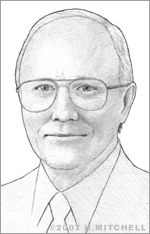Larry Hornbeck
Larry Hornbeck spent nearly two decades developing a revolutionary technology that has, in recent years, begun to offer consumers the chance to enjoy some of the most sophisticated digital imagery ever available. The invention, known as DMD, or the digital micromirror device, is at the core of a system called DLP®, or Digital Light Processing, from Texas Instruments. DLP has brought crystal clear digital images to hundreds of local movie theaters via digital projection systems and to thousands of homes via high-definition television sets. The technology has, in many ways, reset the bar for the visual quality of motion pictures and television programming.
Hornbeck attended Case Western Reserve University in Cleveland, Ohio, earning a BS degree in 1965, an MS in 1968, and a PhD in 1974, all in physics. He joined Texas Instruments (TI) in 1973 as a member of the firm’s Central Research Laboratories staff. In 1977, he began work on optical microelectromechanical systems (MEMs) modulators.
Ten years later, at Texas Instruments, Hornbeck began focusing on ways to use MEMs micromirrors, which are tiny mirrors that are narrower than a single human hair, as part of an all-new digital light modulator. He began looking for a way to use the micromirrors to process incoming light efficiently and convert that light into digital signals. He found that by placing hundreds of thousands of micromirrors in sequence and actuating them to tilt up and down rapidly (thousands of times per second) light could be redirected and processed to project very high resolution images onto a screen while working within a small amount of space.
Hornbeck’s concept evolved into the DMD, a silicon chip containing up to two million micromirror switches. Each of the mirrors on a DMD is movable and individually addressable.
At first, TI used DMD to build an airline ticket printing machine. The first of these machines, the DMD2000, went to market in 1990. Concurrently, TI began working on an initiative that would drive DMD technology toward the high-definition television arena after the U.S. Defense Advanced Research Projects Agency awarded the firm a multimillion-dollar contract for high-definition DMD chip development in 1989. In addition, a private firm seeking ways to project high-definition television in large formats invested money to help develop DMD projector prototypes. TI developed its own internal initiative in 1991, dubbing it the Digital Imaging Venture Project.
Hornbeck was tapped to head up this endeavor. In 1993, he was named a TI Fellow in the company’s newly formed Digital Light Projection Products unit. He received a patent for DMD technology and developed and patented numerous other products, some of which were instrumental in making low-cost DMD manufacturing feasible.
By 1996, TI had completed development on its first DLP products. These products incorporated DMD chips into complex systems that used sophisticated electronics to reflect vibrant, all-digital images onto screens or other flat surfaces. DLP projection systems use a single-chip format, which is capable of creating nearly 17 million colors, or a triple-chip format, which can produce some 35 trillion hues. DLP technology is currently used by dozens of electronics manufacturers around the world. It accounts for approximately 50 percent of the front projection market worldwide.
Hornbeck, meanwhile, has continued to hold the title of Fellow of Technology Development for DLP Products. He holds 33 U.S. patents, has authored more than 30 papers, and has been honored with numerous awards, including the 2004 Daniel Noble Award from the Institute of Electrical and Electronics Engineers, the 2005 Photographic Society of America Progress Medal, and the David Sarnoff Medal Award from the Society of Motion Picture and Television Engineers. In 2015, he received an Academy Award for his contribution to revolutionizing how motion pictures are created, distributed, and viewed.


